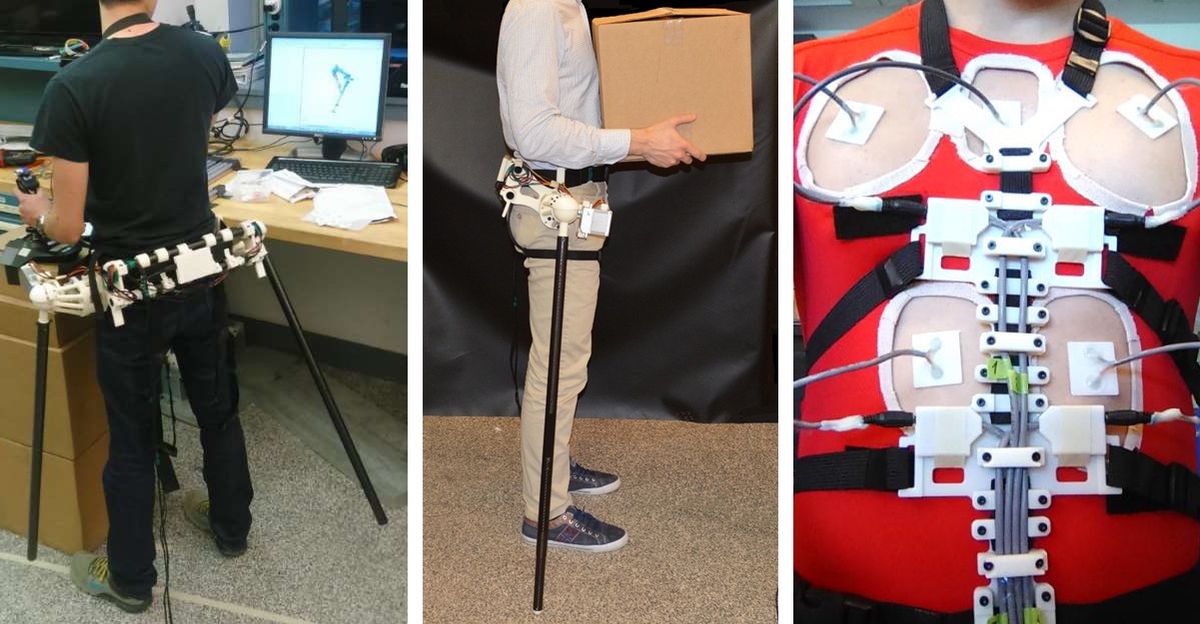I am personally very excited to adopt a few extra robotic limbs, because I have a desperate need to improve my ski-boxing. Other people are probably interested in extra robotic limbs for less exciting reasons, like helping them do their jobs without getting injured. We’ve seen a bunch of research into this area recently, along with a variety of prototypes, and many of them seem like they have the potential to be useful and practical for ski-boxing and whatever else. The difficult thing at this point is controlling those extra limbs, because if you’re using one of your real limbs to control a fake limb, it’s not clear that you’re really coming out ahead.
At the IEEE International Conference on Robotics and Automation (ICRA) last month, researchers from MIT presented a paper on “Independent, Voluntary Control of Extra Robotic Limbs,” which seeks to develop a control system for an extra pair of robotic waist-appendages that’s easy and comfortable to use and doesn’t interfere with control of your real arms and legs.
Here’s the problem with controlling extra robotic limbs or hands: Much of the time, the way that it’s done involves using one of your existing limbs, like controlling an extra arm with your toes. Doing it this way, however, can be kind of limiting when you want to use your real appendages for other things, like walking.
MIT PhD candidate Federico Parietti and engineering professor Harry Asada wanted to come up with a way of controlling a pair of extra limbs that would still allow for full control of your regular legs and arms. In addition to figuring out physically how to make this work, they also needed to answer the question of whether our puny human brains are able to handle six individual limbs instead of just four. Their solution involves hijacking a couple muscle groups in your torso and using them to control the robotic limbs. This can take some practice.
Here’s how they explain the idea, from the abstract:
In order to control additional robotic limbs as if they were part of the user’s body, we need voluntary signals that are independent of natural limb motions and comfortable to measure. One suitable solution—explored in this study—is the use of muscle activation signals generated by the torso. We hypothesize that a human is competent to move the extra limbs voluntarily and independently without interfering with the natural arms and legs.
The robotic limb control comes from four EMG (electromyography) sensors: two stuck to your pecs, and two to your abs. Flexing your left pec rotates the left robotic limb forwards, while flexing your left abs (which is apparently possible, you try it!) rotates the limb backwards. It sounds a little bit awkward, and I’m sure it is, at first, but the question here is whether your brain can adapt to use new muscle groups to drive six limbs in arbitrary directions all at the same time. In other words, can your brain handle walking, using your arms, and driving two extra limbs?

Happily for ski-boxing aficionados like myself, the answer is yes: In a small sample study, users with no prior experience with the system were able to “master the control of additional limbs in a few minutes … in a voluntary and independent fashion.” That is, they were able to accurately and consistently position the extra limbs while doing other things with their other limbs.
Next, the researchers plan to see what other muscle groups they can hack into: They suggest that the trapezius and latissimus dorsi might work, which are muscles in your shoulders and the middle of your back. These muscles could be used to control extra degrees of freedom, or perhaps even more sets of extra limbs. I’m not sure whether my brain would be capable of handling four extra arms, but that’s the surest way to win the ski-boxing championship.
“Independent, Voluntary Control of Extra Robotic Limbs,” by Federico Parietti and H. Harry Asada from MIT was presented at ICRA 2017.
Evan Ackerman is a senior editor at IEEE Spectrum. Since 2007, he has written over 6,000 articles on robotics and technology. He has a degree in Martian geology and is excellent at playing bagpipes.



